- Author: Kathy Keatley Garvey
"When we try to pick out anything by itself, we find it hitched to everything else in the Universe."--John Muir, My First Summer in the Sierra
Ecologist Louie Yang of the UC Davis Department of Entomology, tags that quote at the end of each email.
So true.
On that note, did you catch the Feb. 14th National Public Radio piece on "Why California Almonds Need North Dakota Flowers (And a Few Million Bees)?"
"Here's the web of connections: a threat to California's booming almond business; hard times for honey bees in North Dakota; and high corn prices," Dan Charles said.
The gist of it:
Every year, bees from 1.6 million of the nation's hives are trucked into California to pollinate the 750,000 acres of almonds. Since the almond pollination season is brief--a few weeks in mid-February--the bees need someplace to thrive after the bloom ends. Many beekeepers head to North Dakota's federally funded government program, the Conservation Reserve Program, where flowers bloom all summer long. Basically, Uncle Sam leases land from the farmers to help the bees thrive.
Now, however, North Dakota farmers are finding it more profitable to grow corn than put their land in the Conservation Reserve Program.
"The amount of North Dakota land in the Conservation Reserve, meanwhile, has declined by a third over the past five years," said Charles. "This year, it's expected to take another plunge, perhaps down to half what it was its peak."
So, bottom line, California almonds--and the nation's bees--are tied to the North Dakota's Conservation Reserve Program.
As Charles correctly pointed out: "This is not just a beekeeper's problem anymore. ...the prosperity of almond growers...depends on what happens to bees on the lonely northern Plains."
To get a really good grasp of the situation, read Hannah Nordhaus' excellent book, "The Beekeeper's Lament: How One Man and Half a Billion Honey Bees Help Feed America."
NPR interviewed some of the very migratory beekeepers that Nordhaus interviewed.
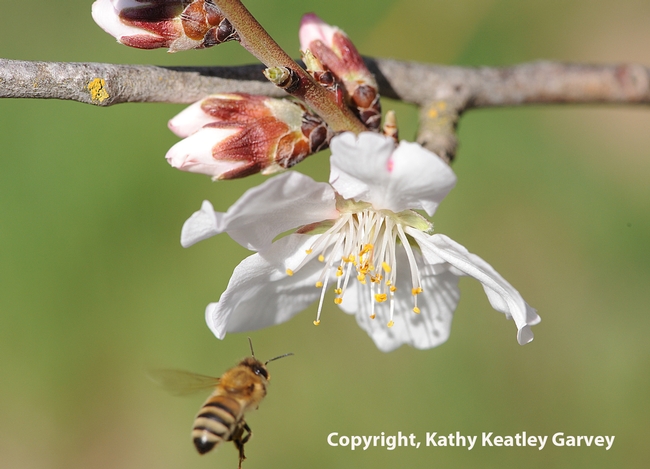
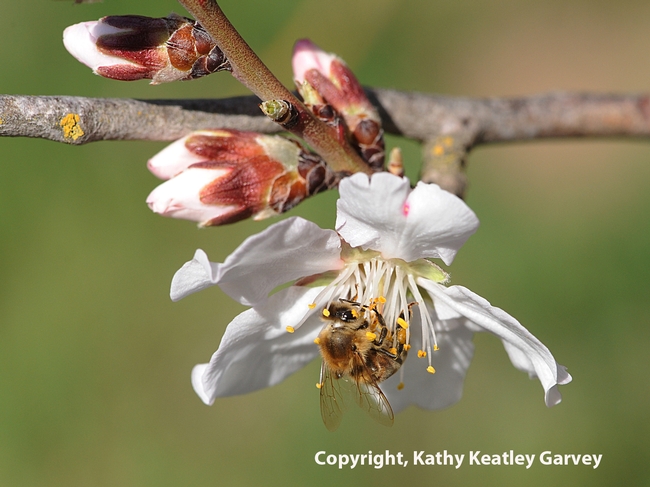
- Author: Kathy Keatley Garvey
At last, the Laidlaw almonds are in bloom.
That would be the almond trees on the grounds of the Harry H. Laidlaw Jr. Honey Bee Research Facility on Bee Biology Road at the University of California, Davis.
And no one appreciates this more than the bees holed up in the 40 hives behind the facility. The bees are getting ready for the big spring build-up, and what's a spring build-up without almonds?
The bees are hungry. Very hungry. If you take a photo of the almond blooms, you'll see how hungry they are. Sometimes you get five bees in one photo.
So, it was with great interest that we read a news story in today's Business Journal, Fresno, that was headlined "New Almond Promises Independence from Bees."
Independence, you ask? Are bees declaring their independence from almonds? No. The piece in The Business Journal concerned the "Independence almond." Wrote reporter Chuck Harvey in the lede: "The Independence almond — a self-fertile variety needing few bees to produce numerous large nuts — is creating a buzz among almond growers."
"Created by Zaiger Genetics Inc., the Independence almond was released in 2008. Dave Wilson Nursery, which holds the patent on the trees, has a producing Independence almond orchard in Modesto."
Basically, it's an early-blooming, self-fertile almond described in the news story as "a large high-grade commercial quality almond with a soft shell," according to the CEO of Dave Wilson Nursery. And it "blanches well."
You'll want to read more about it, and what the Almond Board of California, beekeepers, and growers have to say about it.
One thing's for sure: we need stronger, healthier bees, or we'll all in trouble.


- Author: Kathy Keatley Garvey
"Almonds are one of the first crops of the season that need bee pollination," tweeted the Almond Board of California yesterday.
Valentine's Day traditionally marks the beginning of almond pollination season, but it's an early spring. The almonds are blooming and the bees are buzzing.
So, first the tweets, then the buzzes.
CNN Money, New York, came out Feb. 7 with a news story headlined "Honeybee Die-Off Shouldn't Sting." The Almond Board linked to it in its tweet.
The piece, written by Steve Hargreaves, explored the "good news and bad news on the honeybee beat."
Hargreaves said that colony collapse disorder (CCD) continues to claim about 30 percent of the nation's bees every winter. That's the bad news. The good news, he said, is that "beekeepers have been able to rejuvenate their hives each year so that by summer, the population is back to previous levels."
And "another bit of good news," Hargreaves pointed out, is that although agricultural yields are rising and "rejuvenating beehives is costly," the higher costs aren't being transferred in the supermarket.
Hargreaves quoted UC Davis agricultural economist Daniel Sumner as saying "It shouldn't be a significant item on the radar screen of consumers. It's not that big of a deal."
So, there you have it. Bees are in trouble. Almond production is up (about 750,000 acres in California and each acre requires two hives for pollination). And, demand for almonds is up. California now produces 80 percent of the world's almonds.
Meanwhile, honey bee guru and Extension apiculturist Eric Mussen of the UC Davis Department of Entomology, is repeatedly asked "How are the bees doing?" He writes a bi-monthly from the UC Apiaries newsletter and the periodic Bee Briefs, both posted on the Department of Entomology website.
Mussen attributes CCD (a mysterious malady characterized by adult bees abandoning the hive) to a combination of factors, including parasites, pesticides, pests, diseases, malnutrition and stress.
It continues to amaze us, however, what some folks think is causing CCD. They're looking for a silver bullet. There is none.
The arguments can get ugly. As debates continue to rage in the CNN Money commentary section, one reader, obviously exasperated, posted "...the writers in this place don't know anything about the realms of science, economics or ecology. And 90 percent of the posters aren't very bright, either."
Meanwhile, the bees are busy pollinating almonds.
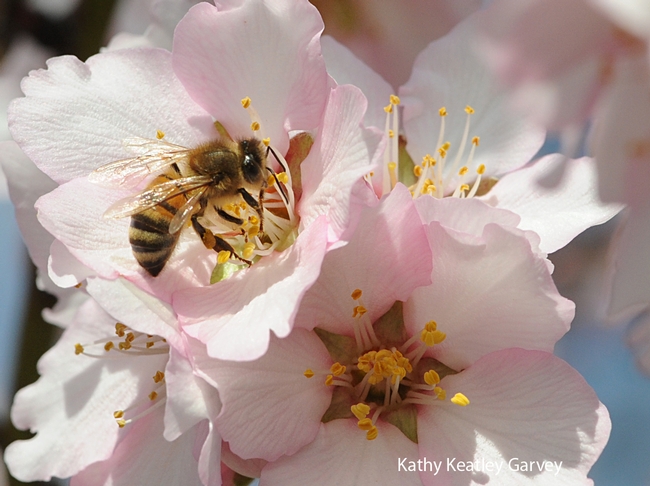
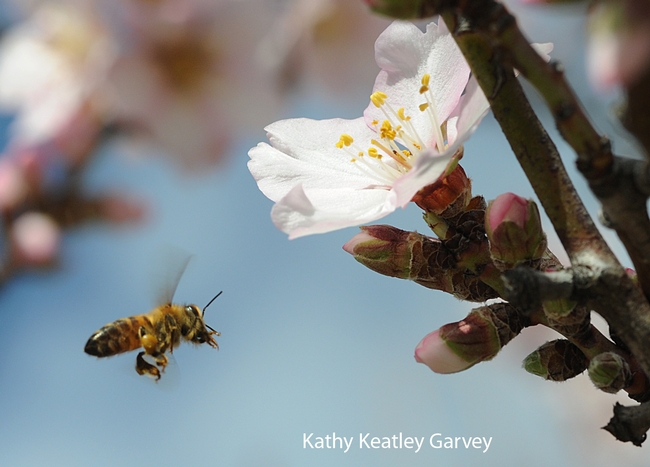
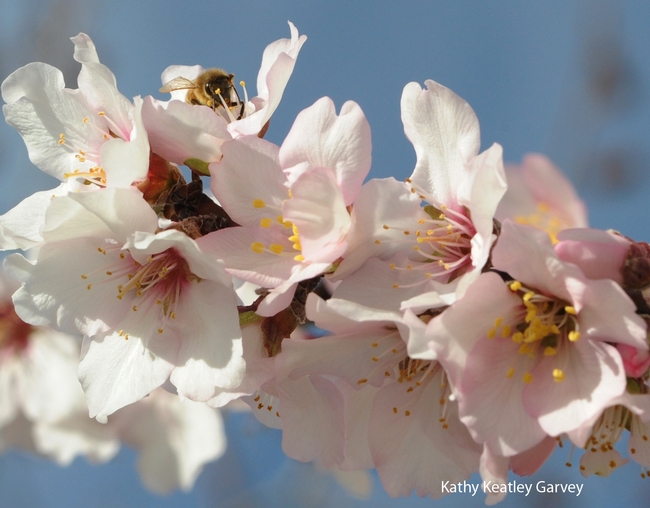
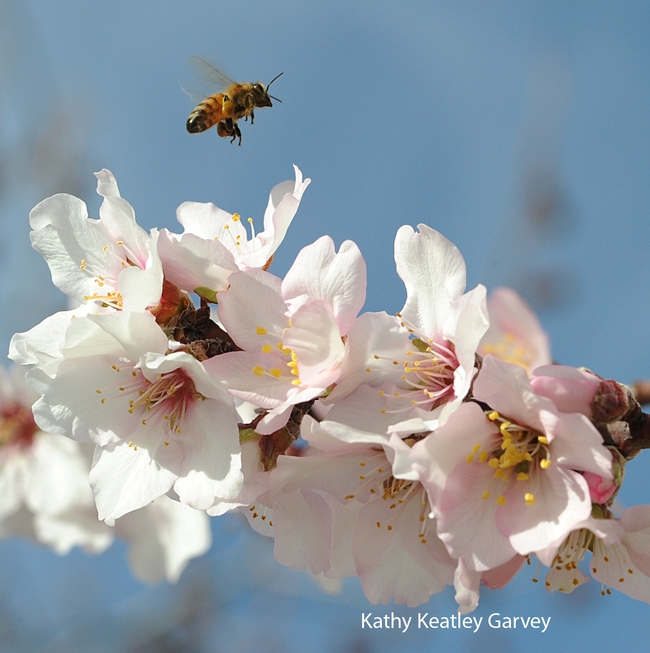
- Author: Kathy Keatley Garvey
It's not too early to start thinking about NPW.
NPW? National Pollinator Week.
They are a key to our global sustainability and food supply. Eighty-percent of the world's crops depend on pollination. Honey bees pollinate about one-third of the food we eat.
Worldwide, we have about 20,000 species of bees, according to native pollinator specialist Robbin Thorp, emeritus professor of entomology at UC Davis. And California alone, he says, has more than 1600 species. Bees include sweat bees, digger bees, leafcutting bees, bumble bees, and scores of others.
Want to know what to plant in your garden to attract bees and other pollinators? Good sites to read are UC Berkeley's Urban Bee Gardens Web site and the Xerces Society Web site.
Meanwhile, almond blossoms are in full bloom in California. At the Harry H. Laidlaw Jr. Honey Bee Research Facility at UC Davis, an almond tree near the apiary is a burst of blossoms and a flash of aromatic fury.
Walk by the tree and you'll see pollen-packing honey bees buzzing around like there's no tomorrow.
We must ensure there will be a tomorrow.




- Author: Kathy Keatley Garvey
It's Presidents' Day today, a holiday for most of us but not for the honey bees.
The bees are buzzing in and around the almond blossoms, collecting nectar and pollen for their hives. Nectar provides the carbohydrates for the hive, and pollen provides the proteins.
Someone told me yesterday that she thought that the drones (males) gather the nectar and pollen. Not so. (Shades of the inaccurate information released in Jerry Seinfeld's "The Bee Movie" and the equally inaccurate term, "pollen jocks.") No, the only function of the drones is reproduction. When the virgin queen bee heads out on her maiden flight, she'll mate with 12 to 25 drones or so in the drone congregation area. Then the drones die. Happy, probably. If they don't mate, they'll die within a month. Sad, probably.
The queen bee, in peak season, will lay about 2000 eggs a day. The worker bees--all sterile female workers--serve as the nurse maids, nannies, royal attendants, builders, architects, foragers, dancers, honey tenders, pollen packers, propolis or "glue" specialists, air conditioning and heating technicians, guards, and undertakers.
It's a matriarchal society.
So when you see the bees buzzing around the almond blossoms, they're girls. Busy girls. Golden girls. They not only buzz, they rock.
They're the ones that pollinate one-third of the food we eat, including California's 700,000 acres of almonds.
You go, girls!






